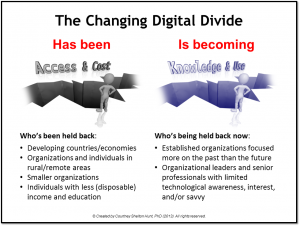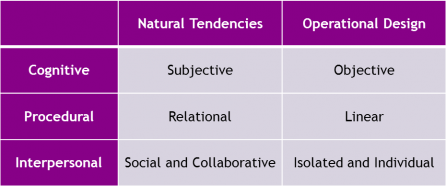Summary: The digital divide has increasingly become about knowledge and adoption of new technologies rather than access. Which side of the divide are you on – are you a leader or a laggard? This post offers insights into the factors contributing to the growing chasm between those who have embraced and leveraged new technologies and those who haven’t. It also offers suggestions for bridging and crossing the divide. Dialogue is encouraged and insights and questions from others are welcome. (from the Denovati SMART Blog)
For most of the early part of the Digital Era, we viewed the digital divide primarily in demographic terms such as geography, socioeconomic status, and age (see this Wikiepedia entry for details). But as digital technologies continue to improve, get less expensive and grow more widespread, those gaps are closing or becoming less relevant. Gaps based on knowledge and use, however, remain strong – and in fact may be getting larger. Over time it seems – and especially with respect to the adoption of social and digital technologies in organizations – the digital divide is defined less by “we can’t” and more by “we don’t wanna.”
In this post I share my thoughts on six key realities that help put the current digital divide in perspective and offer food for thought, particularly for later adopters and technology resisters. It’s not intended to be an indictment against laggards and luddites – rather, my intent is to offer a practical assessment and generate dialogue about the challenges we face as technology increasingly outstrips our willingness and ability to embrace, adopt, and master it. To help us figure out how to move forward, I also share a few ideas on what it will take – both collectively and individually – to bridge and cross the divide.
(click image to enlarge)
Understanding the New Digital Divide
The more I speak to and work with individuals and organizations to help them adapt to Digital Era realities and adopt new social and digital technologies and tools, the more clear certain realities become. Here are some I’m reminded of on a daily basis.
It’s never been so easy to do so much with so little. The technological and financial barriers to adoption of incredibly powerful tools and platforms are generally very low. Free and low-cost options are abundant. In addition, software-as-a-service (SaaS) and cloud-based networks reduce (or eliminate) the need for large investments in hardware. New software and hardware also dramatically increase the ease of design, drastically reduce the time to implementation, and significantly enhance long-term system flexibility.
New technologies create a “people paradox.” Although the idea is counter-intuitive to many, people are much more central to the Digital Era opportunities and challenges we face than technology. As I discuss in Social Media Management: From Novelty to Utility, digital technology is an enabler – a means to various ends rather than an end in and of itself. We must view these new technologies as sources of power and recognize the importance of human beings in determining the effectiveness of our ability to harness and manage that power.
The (r)evolution is bigger than we think. Many people falsely assume that new technologies only impact organizations in certain sectors (e.g., consumer goods and services), specific functional areas (e.g., marketing), and individuals in certain types of jobs and professions (e.g., IT) or at particular stages in their work lives and careers (e.g., digital natives). The reality, however, is that new technologies potentially impact every type of worker, in every sector, at every career stage and every organizational level, throughout the world.
We get in our own way. Though technological and financial barriers may be low, psychological barriers to new technology adoption are very high. These barriers are both cognitive and affective, and each type of resistance reinforces the other. The foundation of the resistance is a lack of conceptual understanding of how new technologies enable the pursuit and achievement of traditional goals (i.e., they’re new tools for doing old things (in new ways)). This lack of understanding leads to:
- Underestimating opportunities
- Overestimating challenges
- Misestimating risks
We live in the past and like to play it safe. Temperamentally, most humans have a tendency to look backward rather than forward. We concentrate more on “how things have always been done” rather than what’s possible. We’re also generally risk averse, especially when evaluating options that can produce potential gains. Given a choice, most of us prefer the “devil we know” to the “angel we haven’t met yet.”
Click here for more on the barriers to digital engagement
We’re conditioned to be Luddites. Another significant barrier is that most organizations – from schools to public sector entities to for-profit enterprises – are dominated by Industrial Era thinking and operations. Ironically, even though our natural tendencies are cognitively subjective, procedurally relational, and interpersonally social and collaborative, most of us learn and work in environments that emphasize objectivity, linearity, and (isolated) individualism.
Bridging and Crossing the Digital Divide
To me, leadership is the key to bridging and crossing the new digital divide. And it can occur in multiple forms:
Thought leaders and champions need to not just trumpet the “cool” aspects of new technologies, but also their practical benefits. They need to frame their arguments from the perspective of what other people need to hear rather than what they themselves want to say. And they need to think bigger and more broadly about the phenomena they’re touting.
Formal organizational leaders need to educate themselves about new technologies, their applications, and their implications. Doing so will enable them to provide the strategic direction and the capacity – especially in terms of human capital – their organizations need to move forward. It will also enable them to adapt their leadership styles to enhance their ability to be successful in new operating environments.
Educators at all levels – and especially in higher education – also need to educate themselves about new technologies and their applications and implications. They need to then use their new-found knowledge and understanding to update their curricula and pedagogical practices, as well as their research questions and methods.
Informal leaders who understand new technologies and their benefits and challenges can help others make the necessary transitions by being champions and cheerleaders, leading by example, and offering guidance, instruction, and encouragement.
Self-leadership means we will all take it upon ourselves to understand new digital technologies and make educated and informed choices about which technologies we will embrace and leverage. We’ll also commit to learning and excelling at the competencies necessary for Digital Era success.
Your Thoughts?
What other realities and challenges do you see? What questions and concerns do you have? What additional ideas would you offer for bridging and crossing the digital divide?
As always, your comments and questions are welcome.







Leave a Reply
You must be logged in to post a comment.